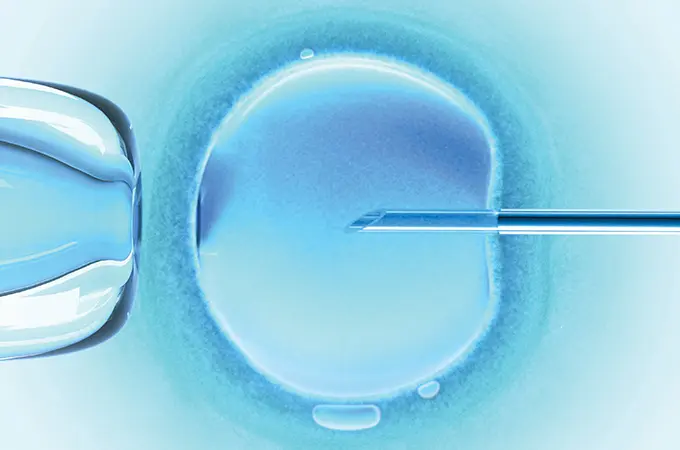Shady Grove Fertility, a leader in reproductive medicine and clinical research, published a new study that confirmed that retrieval of larger cohorts of eggs leads to more live births, refuting several recent publications suggesting that milder stimulation and retrieval of smaller egg cohorts maximizes births rates.
In a normal ovulation cycle, one egg matures per month. The goal of an in vitro fertilization (IVF) cycle is to have many mature eggs available. In order for there to be more than one egg available, stimulation of the ovaries needs to occur to produce more eggs.
It has been suggested when high numbers of eggs are retrieved in an IVF cycle, the chance of pregnancy may be lower. We recently completed a retrospective study to determine whether this is true. The hypothesis was: Retrieval of high numbers of eggs does not adversely affect outcomes of in vitro fertilization. Key findings of the study were presented yesterday at the 2016 American Society for Reproductive Medicine (ASRM) Scientific Congress & Expo (October 15 to 19, 2016). In fact, this study in particular was one of only a few deemed to have exceptional clinical importance.
Researchers evaluated 8,573 autologous IVF cycles performed between 2009 and 2014 among patients under 35 years of age.
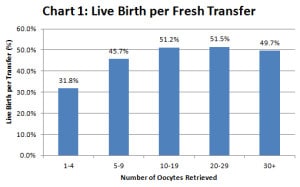
The data revealed a number of key findings. The first was that when the number of eggs retrieved per cycle increased, so did the likelihood of a live birth per fresh embryo transfer procedure. There was a significant increase in birth rates with 10 to 19 eggs compared to five to nine eggs, but there was no significant increase or decrease in birth rates per fresh transfer when greater numbers of eggs were retrieved.
Analysis of births per fresh embryo transferred showed an increase in the percentage of children born per
embryo transferred when 10 to 19 eggs were retrieved compared to smaller egg
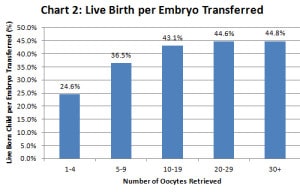
cohorts. The percentage of transferred embryos that resulted in live born children began to plateau when more eggs were retrieved, but it did not decline. These results suggest that retrieval of larger egg cohorts did not compromise either the quality of the embryos transferred or the ability for the uterus to support implantation and pregnancy, following an IVF cycle productive of high egg numbers, which usually entails high serum estradiol levels.
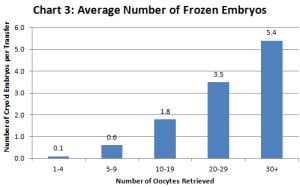
The average number of surplus high-quality embryos available to freeze after fresh embryo transfers increased as the number of eggs retrieved increased. Freezing embryos for use at a later time is called a frozen embryo transfer (FET).
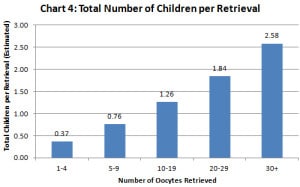
When the number of eggs retrieved increases, the total number of babies that can be born per egg retrieval increases.
What this Means for Patients
This research demonstrates that in vitro fertilization success rates do not improve if fewer eggs are retrieved per IVF cycle. Shady Grove Fertility’s results show the exact opposite. There is no decline in live birth rates per fresh embryo transfer in cycles with more eggs retrieved.
In addition, when more eggs are retrieved per IVF cycle, there is a greater likelihood of having more high quality embryos available to freeze for later use. As a result, retrieval of more eggs maximizes chances of more babies born per retrieval and minimizes the number of IVF cycles a patient needs to build their family.
About the ASRM 2016 Scientific Congress & Expo
The 2016 ASRM Scientific Congress & Expo is the premier scientific congress for reproductive medicine that will address state-of-the-art issues in reproductive medicine and science. Held from October 15 to 19, 2016, in Salt Lake City, UT, the theme of the 2016 Scientific Congress of the American Society for Reproductive Medicine is “Scaling New Heights in Reproductive Medicine.” The program features scientific, postgraduate, and video presentations as well as plenary lectures addressing the most pressing clinical and basic-science issues in reproductive medicine.
To learn more about the study presented at ASRM or to schedule an appointment, please call our New Patient Center at 1-877-971-7755.

